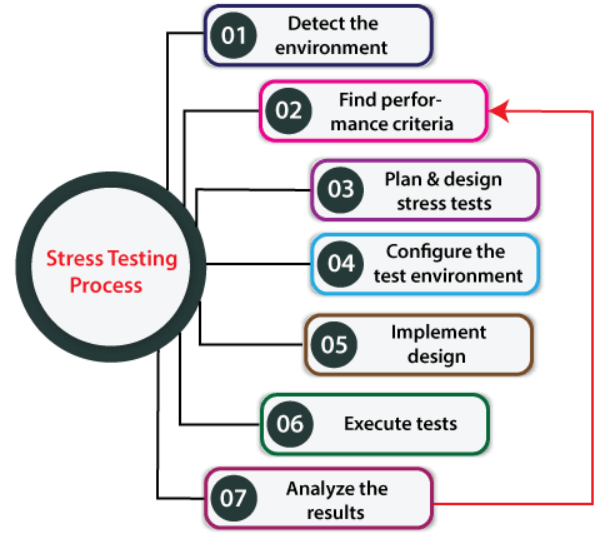Stress testing is a form of testing that is used to ensure that software is accessible and robust beyond its normal functional limits. It is mostly intended for critical software, but it can be implemented into any type of software. Under non-functional testing, stress testing is an integral aspect of performance testing.
To achieve the outputs, this testing involves testing beyond standard operational scale, repeatedly to a breaking point. Instead of appropriate behavior under normal conditions, it emphasizes error management and robustness under a heavy load.
Objective of Stress Testing:
- The primary goal of this testing is to ensure that the application does not crash when computing resources such as disc space, memory, and network requests are in short supply.
- It ensures that the system fails and recovers without trouble, which is known as the recoverability phase.
- It can be used to detect hardware and data corruption problems.
- It would help us in identifying security flaws that can emerge during spans of continuous peak load.
Features of Stress Testing:
- It also ensures that unanticipated errors do not compromise security.
- It’s used to find out how a device operates in unusual conditions and how it responds after a failure.
- It is used to determine whether or not the device has saved the data before crashing.
- When the device is stressed, this testing ensures that the appropriate error message is shown.
Why do we perform Stress Testing:
- A correct error message should be shown when the system is under stress.
- In order to see how the device operates in unusual situations.
- If the device fails in high-risk cases, it could cost a lot of money.
- We would be prepared for severe situations if we use this testing.
Examples of Stress Testing:
- When e-commerce or online shopping sites announce a sale during the festival, traffic will surge. When an article is mentioned in a major newspaper, it may result in a spike in traffic. If we fail to assist, this sudden traffic can result in loss of profits and status so we need to perform Stress testing.
- On the education board’s result website, stress testing is mandatory. Many students, users, and applicants will log in to check their grades on the day of the results. As a result, stress testing helps in reducing application failure and evaluating efficiency and recoverability when the ultimate load occurs in a short period of time.
How to perform Stress Testing:

- Detecting the environment: The first step for stress testing to find out the available resources, tools, software, hardware, and network configuration.
- Finding Performance Acceptance Criteria: It helps us in identifying the metrics used to stress-test the application’s efficiency. Often, determining the success criteria for a stress test, such as the maximum load that can be applied to an application before it fails.
- Plan and Design Stress Test: In this step, we design the test plan/scenarios.
- Configure the test environment: After the stress test plan has been successfully created, we’ll move on to the next phase, which is to set up the test environment, equipment, and resources needed to execute each method as new features and components become available for testing.
- Implementation of Design: After configuring the test environment, we’ll create stress tests to see which test design performs the best.
- Execute Tests: In this step, we will run the test, observe and validate the results, as well as collect test data and performance.
- Analyzing the test results: In this step, the results will be analyzed, and the production data from the various teams will be combined and shared.
Advantages:
- Stress testing explains how a machine acts after a malfunction and guarantees that it recovers rapidly from crashes.
- The most important benefit of stress testing is that it will enable the device to function properly under both normal and abnormal situations.
- It defines the software’s scalability and improves its efficiency.
Disadvantages:
- Even open-source tools such as JMeter need a load testing environment that is as similar to the production environment as possible.
- If we’re writing a Stress test script, the person writing it should have sufficient scripting knowledge of the tool’s supported language.
- If we use stress testing, we will need more time, which will make this testing more expensive.
- If we perform the Stress Testing manually, it will be a time-consuming and challenging job to complete, and the results may not be as anticipated.
Knowledge of .NET is quite rewarding in the IT industry. If you have got some skills in the .NET framework then a .NET Certification Exam from StudySection can prove to be a good attachment with your resume. You can go for a foundation level certificate as well as an advanced level certificate in the .NET framework.




